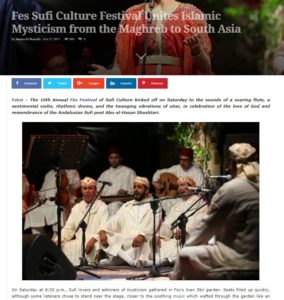A search for Sufis on YouTube may draw the viewer into a vicarious visit to the thirteenth-century shrine of Moinuddin Chishti in Ajmer, India, in the company of a Sufi shaykh with a long white beard wearing a turban in the Turkish style. Accompanied by South Asian Sufi music, we drive until the streets become too narrow, then navigate the crowds on foot before arriving at the Chishty Munzil (house), just outside the shrine itself. The shaykh is Muhammad Hisham Kabbani, a spiritual leader of the Naqshbandi-Haqqanis, a rapidly growing branch of the Naqshbandi Sufi Order that emerged from Turkey in 1973. He is guided on his journey through the narrow streets by a younger man, dressed in the garb of an elite Indian Muslim. This is Haji Syed Salman Chishty, a gaddi nashin (spiritual and hereditary successor) of the great saint of the Chishti Sufi order. In this transnational encounter, Shaykh Hisham settles onto a carpet on the roof of the building, which overlooks the shrine itself. One of the men sitting near him holds up a smartphone to record a video and the shaykh speaks—not to the audience present in front of him, but to the phone. He offers a blessing for the thirteenth-century Chishti saint and then says, in English: “From the high mountains of India, the high auliya (friends of God) of Moinuddin Chishti, sending salaam around the world. . . .”
The words, sounds, and images of the brief YouTube video of the meeting of Shakyh Hisham and Haji Syed Salman Chishty can be read in relationship to a complex field of competing images and very different deployments of YouTube, Facebook, and the personal website. These particular Sufis have used media in ways that upend the usual rituals of status and authority within Sufi orders while pushing against powerful global forces that would seek to delegitimize Sufism as unIslamic and archaic. Their interlocutors are a public that is different from the close circles of followers associated with most shaykhs of the Naqshbandi, Chishti, and other Sufi orders. They are competing for followers who might otherwise be drawn to a very different kind of website, created by Muslims who assert that most aspects of Sufi practice, and sometimes even Sufism itself, are unIslamic. More controversially for many Muslims, they are also engaging an audience that does not identify as Muslim but is drawn to Sufism’s “spirituality.”
Many young Muslims today turn to the internet to learn about Islam. When they do, they are likely to come across sites like IslamiCity, which promotes a very specific sort of Islam. In the 1990s, Saudi-linked initiatives quickly colonized areas of the internet and sought to strip Islam of innovations that have accrued over centuries. This “Salafi” Islam was simultaneously a return to the model of the Prophet Muhammad and his Companions and a modernization of Islam. Such Salafi-influenced internet presentations of Islam are heavily biased against Sufi approaches. On most of these Islamic websites, Sufis are simply invisible. Naqatube, the Saudi answer to YouTube, offers a filter that seems to exclude Sufis altogether. A search for “Sufi” on the United States-based Islamictube—which has unsuccessfully attempted to rival YouTube for the attention of Muslims—similarly turns up no hits. When Sufi practices are occasionally mentioned on IslamiCity, it is only to dismiss them as superstitious traditions that have no place in the modern world. YouTube itself, with its open format and automatically generated links to other YouTube posts, is thus one of the few places where the Muslim seeker is likely to stumble across anything related to Sufism. Shaykh Hisham’s visit to Ajmer is one of the events they are likely to encounter while looking for Sufis.
Though representing different Sufi orders, both Shaykh Hisham and Haji Syed Salman Chishty are accomplished users of the internet who promote similar messages of inclusiveness that skirt the edges of controversy as they push the boundaries of Sufi and Muslim communities. Like many other Sufis, they are visible on YouTube and have Facebook pages. But their sites are notable for the dynamic quality of their internet presence, with a dense web of links that can draw both the curious and the disciple alike into deepening involvement with their messages, their books, and their visual and audible presence in photographs and well-shot videos. At the meeting in Ajmer, their messages are captured on the banner hanging over their heads: “Come, come again! Whoever you are!”—a quotation from the thirteenth-century Persian Sufi poet Jalaluddin Rumi. The core message of these Sufis is recruitment and unity—the creation of a new, global public that is attracted by a message very different from the one promoted by the anti-Sufi preachers who are so visible on the internet. Just as the Islam websites mentioned above engage in boundary-drawing, offering detailed specifications of how the proper Muslim should and should not behave, these Sufis compete on the same global turf, attracting youth by offering a message of spirituality, love, and brotherhood.
Though both shaykhs are members of major Sufi orders with long, venerable histories, their invitation also stands in tension with the disciplinary techniques of these orders, which are taught through personal interactions between shaykh and disciple within a small circle of fellow disciples. The openness of this public is closer to what happens when large crowds of diverse backgrounds, including many Hindus, attend festivals and musical performances at the shrine. Yet, in contrast to the experience of the crowds who are touched by the Chishtis but never get very close to the shaykh, the viewer who is drawn in through the internet experiences the shaykh as if present right in front of him, with no one to block the view.
Many Sufis appear on YouTube, but most lack the kind of internet visibility that reaches into new publics. Haji Syed Salman Chishty is one of several gaddi nashins associated with the shrine of Moinuddin Chishti. It is common for ritual gatherings at the shrine to be recorded on a smartphone and uploaded to YouTube, yet few events are designed to accommodate the distant presence of a future public. Given the importance of the shrine, these other leaders may even have important contacts, receiving visitors such the prime ministers of India and Pakistan, or even speaking before the United Nations, as Dewan Syed Zainul Abedin did in 2000, but such an appearance does not translate into a recruitment strategy. Dewan Abedin’s online presence emphasizes his legitimate succession as the closest direct descendant Moinuddin Chishti and his right to run certain events at the shrine, as guaranteed by the Indian courts since the colonial era. But most YouTube videos of him record events that are staged without a single focal point. These videos often reveal multiple smartphones operating at once, as in the video shot by an attendee of the important event in which the Dewan designated his son as his successor by wrapping a turban on his head. Like the rest of the attendees on the fringes, the online viewer struggles for a clear view of the ritual.
The one activity at the shrine that does allow for a more developed YouTube presence is Qawwali (Sufi devotional music). The Chishti Order has always been distinctive for its patronage of music, in contrast to most other orders in South Asia, which have viewed musical performance as a violation of Sharia. Regular Qawwali performances draw large crowds of all backgrounds to the shrine. Some of these are professionally recorded and posted by the recording company itself, especially when the performance takes the form of a concert held at a space for cultural events, rather than a ritual at the shrine at which devotees approach the shaykh to shower money on him, where some fall into trance and are placed prostrate before him.
Haji Syed Salman Chishty, who has a BA in Economics and Commerce, has established the annual Rung Festival, where the meeting with Shaykh Hisham took place. His activities blur the line between “religion” and “culture.” The walls of the hall where he received Shaykh Hisham were set up as an art gallery for paintings and calligraphy with Sufi themes, and he himself is a photographer whose images of his Sufi journeys are exhibited in galleries and photography exhibitions. He speaks at conferences and universities on spirituality and interfaith dialogue, and his Rung Foundation promotes charitable service while spreading a message of love across forty countries (according to their website). Shaykh Hisham is a somewhat controversial figure within the Haqqani branch of the Naqshbandi Sufi order. The Naqshbandis have historically prohibited the use of music in their gatherings. But the Haqqani branch has focused on music and the internet to carry out their mission of revitalizing Sufism, as Francesco Piraino has explored. One of the European khalifas performs with his own band throughout Europe and posts videos of his music. Shaykh Hisham is the US khalifa, and his digital presence in the form of videos, books, iPhone apps, and multiple websites engages a large and expanding public, but has led to suspicion within the order as his visibility begins to rival that of the founding shaykh himself. The order’s loose structure, fluid membership, and a laxness about adherence to Sharia bring the order toward the realm of what has been called “New Age Sufism,” drawing in followers who do not necessarily see themselves as having any connection to Islam itself. It also reinforces criticisms of Sufism that have been pervasive among Muslims who are concerned with protecting the boundaries of Islam.
Shaykh Hisham, Haji Syed Salman Chishty, and other Sufis such as Faouzi Skali, founder of the Fes Sufi Culture Festival in Morocco, have sought to appeal to this potential public by linking Sufism to a modern global culture. Skali, who is himself from an important Sufi family, had felt that his family’s own practices were out of touch with the modern world and founded the festival to “bring the spirit of Sufism back to its early glory.” At the 2017 festival, Skali invited the audience to experience a “journey in the footsteps of the great mystic Ibn Arabi, following Ibn Battuta, who traveled throughout the world, pursuing the magic of the Sufi brotherhoods.”
These modern Sufis have recognized the importance of music and the arts as a recruitment tool for forming a new Sufi public, not only through cultural events that draw large audiences but also through the presence of these events on the internet. Yet these Sufis also recognize the importance of continuity with the Sufi Orders and the succession of Sufi saints across the centuries. The meeting of Shaykh Hashim and Haji Syed Salman Chishty was a stop on a Sufi journey, much as Ibn Battuta would have done and written about in the fourteenth century, this time recorded for a future Sufi public to experience on their computers, where they can also consult a map of Haqqani-Naqshbandi centers across the world, complete with phone numbers and the schedule of meetings for zikr (devotional recitation).
Today in public discourse, orientations toward Islam have increasingly come to be understood in terms of a global divide between Salafis and Sufis. With growing sophistication, Sufi and anti-Sufi approaches compete for Muslim publics through an array of new media and play a key role in creating this Sufi-Salafi divide. Since Muslims are as likely to learn about how to practice their religion through these media as they are through their parents and local religious teachers, scholarly attention to forms of religious publicity is crucial for understanding the evolution of Muslim communities and Islamic practice.














